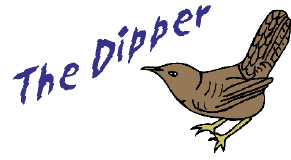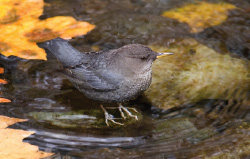


This bird is known as the water ouzel. It is related to the wrens, but has been equipped to live in a very different way than its cousins. Nicknamed the "dipper" because of its bobbing habit, this bird feeds on insect larvae, fish eggs, and other small creatures at the bottom of streams in the western United States. They can dive as deep as twenty feet and spend a large percentage of their daytime under water. They will swim in rapids and have no fear of white water.
Wrens are generally not associated with water, but this bird
is wonderfully adapted to its lifestyle. Under their outer
feathers they have a thick layer of downy feathers which keep them
insulated against the cold of the mountain streams they usually
inhabit. They have a gland near their tail that is full of oil,
and while all birds have glands that help th em maintain their feathers, the water ouzel has ten
times more of this water-repelling oil than other birds. They rub
this oil on their outer feathers and are essentially waterproof as they
dive and swim after their food. The feet of the water ouzel are
not webbed, and their swimming is done by their wings. The feet
are used for hanging on to rocks as they nest under waterfalls, and
scratching along the bottom of the streams for imbedded foods.
Webbed feet would actually be a liability for these vital
functions. They build their nests with moss and ferns, usually
under the lip of a waterfall where the nest is very safe.
em maintain their feathers, the water ouzel has ten
times more of this water-repelling oil than other birds. They rub
this oil on their outer feathers and are essentially waterproof as they
dive and swim after their food. The feet of the water ouzel are
not webbed, and their swimming is done by their wings. The feet
are used for hanging on to rocks as they nest under waterfalls, and
scratching along the bottom of the streams for imbedded foods.
Webbed feet would actually be a liability for these vital
functions. They build their nests with moss and ferns, usually
under the lip of a waterfall where the nest is very safe.
Evolutionary scenarios for the development of the equipment of the water ouzel will suggest a gradual adaptation to a water environment. It is clear that there is an elaborate design of a variety of physical features that allows the dipper to live as it does. Design features that involve chemistry and specialized physical features suggest an intelligence is behind the features we see. Chance explanations and gradualism stretch credibility very thin in cases like this. God has special designs for special creatures and the water ouzel is one of those. Data from: Jack Elrod, "Mark Trail" comic strip, February 3, 2008.
Back to Contents Does God Exist?, NovDec08.